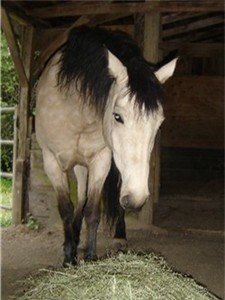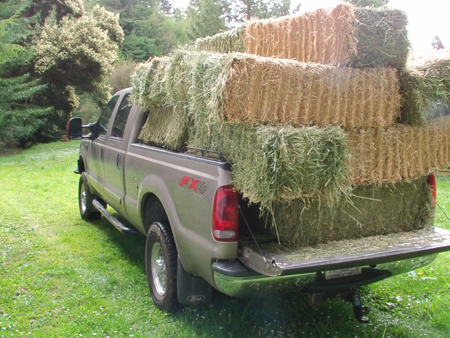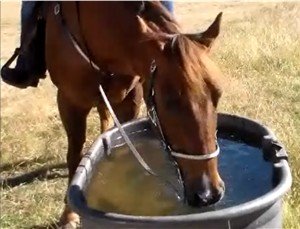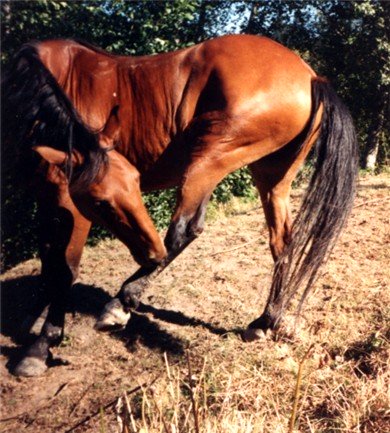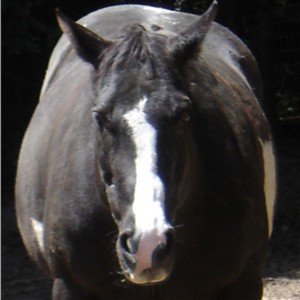Horse Hay: Guide to Feeding A Horse
Learn the horse hay pro's and con's of alfalfa, oat and grass hays. Which ones are best for your horses and how much hay you should be feeding them.
A word of advice from someone who has lost a horse to emphysema...regardless of what type of hay you choose to feed your horse...buy the best quality hay you can afford. Use only quality hay for horses. By doing the one simple thing, you greatly increase the health and life span of your horse.
How Much Hay Should I Feed My Horse?
Well, that all depends on the horse’s size, age and work load. A mature horse can eat 3% of its body weight daily. That’s 30 lbs of hay per day for a 1000 lb horse. This is only a rough guide. Your horse may need more or less feed depending on whether he's an 'easy keeper' or a ' hard keeper'.
A good rule of thumb is to feed your horse the amount of hay she can clean up in about 1½ - 2 hours. The roughage in horse hay requires a good bit of chewing. If your horse is cleaning it all up in less than an hour, chances are he’s not getting enough. If it takes more than 2 hours she’s more than likely trampling and wasting the excess hay.
A horse eats 2.5-3% of it's body weight daily
A 1000 pound horse = 25-30 pounds of feed a day
Determine Feed Rations
Multiply your horse's weight by .03 to find how many pounds of feed (hay and grain) your horse will need per day.
Unlike the predatory wolf, a horse’s gut is not designed to handle single large meals. As grazers, the horse is designed to eat small amounts all day long. Ideally a horse should eat several times a day, but this is not very practical for the horse owner! You should feed your horse a minimum of twice a day.
If your horse is getting too heavy, cut back on the feed…including grain rations. If your horse is loosing weight, increase the rations. A note about weight loss, be sure it is not due to parasites or the need for dental work. And pardon me while I sate the obvious:
Always feed your the amount needed to maintain a healthy body weight and condition!

There are Only 3 Types of Horse Hay
Legume (leafy) Hay
- Alfalfa
- Clover
Grass Hay
- Timothy
- Orchard
- Brome
- Blue grass
Cereal Grain Hay
- Oat hay
- Barely
- Wheat
- Rye
Pound for pound, alfalfa and clover hay have the highest energy and nutritional value of all the hay types. They contain twice as much protein, three times the calcium and have the highest vitamin content.
These legumes make a good feed choice for growing foals, pregnant and lactating mares, as they have higher nutritional needs during this period in their lives. If grasses or cereal grain hays are fed, the additional nutrients can be made up for by adding grain rations.
The down side of clover and alfalfa hay is that the high protein content can be too much for some horses. That is, horses with laminitis or horses with allergies. High protein hay for horses can also contribute to heat exhaustion and excessive sweating for hard working horses in very hot areas.
Grass type horse hays have a lower nutritional value than legumes, but are considered ‘safe’ hays, because it is harder for a horse to over eat or have a reaction to grass hay. An additional benefit to grass hay is that is easier on the kidney's due to it's lower protein content and it tends to have finer stems, making it easier to chew and digest…..nice for senior horses.
Cereal grain hay, is hay that has not had the grain harvested. These hays have about the same nutritional value of grass hays. But be aware, if cereal grain hay is harvested in such a way as to loose the seed heads, the remaining straw is of poor nutritional value and only suitable for bedding. Cereal grain hays have a higher concentration of nitrates. Not good for horses with laminitis.

Quality Hay for Horses is King
See the Difference?
Notice the difference in these two cuts of alfalfa hay. One cut has a much finer stem than the other.
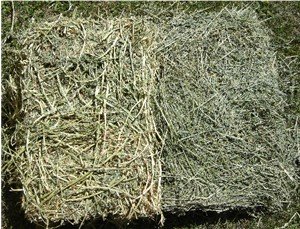
The quality of horse hay varies greatly depending on a variety of factors. When it is harvested, how it is harvested and whether the cut is made late or early in the season. Geography and soil quality play a role as well. Many parts of the U.S. are low in selenium and produce low selenium content hay. See selenium deficiency to learn more.
Look for hay that is bright green in color, soft and pliable, fine stemmed and harvested before the plant reaches full maturity. The longer the hay is stored and the more yellow it becomes, the more it looses its nutritional value, especially essential minerals for horses.
Avoid horse hay that shows any sign of mold or musty smell. These have been known to cause coughing, heaves and emphysema. Avoid dusty or dirty hay. This can happen with hay that has been cut too low. The dirt piles from gofer holes and uneven ground can literally get processed right up into the hay bales. Not good.
Try to limit sand ingestion by not feeding your horse directly off the ground. Rubber mats or even carpeting placed on the ground can act as a sand barrier. Horses tend to throw their hay around as they rummage for the good bits, so you’ll need a good 8’ by 8’ of ground cover for your horses feeding area.
A high quality cereal grain hay, like oat hay, is preferable to a poor quality alfalfa. Use your good judgment when purchasing hay for horses. You may find that the quality of hay available at your local feed store changes during the seasons. Choose the best you can.
If you find yourself buying a different kind of hay than your horses are currently eating, be sure and introduce the new feed slowly over the course of a week or two. This will reduce the chances of horse colic or founder.
More Equine Topics You'll Enjoy
Grain for Horses
How much horse grain feed should I feed my horse? Learn the difference between corn and rolled oats and more!
Return to top of Horse Hay Types page to easily access the navigation bar on the left for more at Equine Spot.
